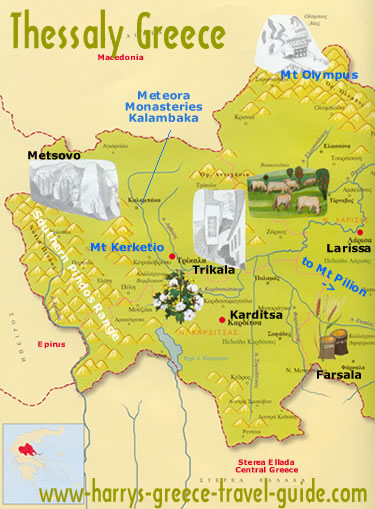
This area includes most of the huge plain of Thessaly on the southern end, where cotton, grains and tobacco are cultivated.
This highest mountain in Greece (2917 meters, or 9568 feet) at its highest point) has a little more than one tenth of its total area of around 98,800 acres (40,000 hectares) protected within the National Park named for it.
It is most special for its flowers and birds. There are some 1800 species of flora on the mountain, with some 25 species (estimates vary) endemic, with others quite rare.
Mostly limestone, the mountain has a very varied landscape, which includes scrub, deciduous and coniferous forest, ravines, bare rock, high pastures and screes, streams and snowfields.
 Though there are quite a few other approaches, most people begin the hike up Olympus from the village of Litohoro which has plenty of visitor accommodation.
Though there are quite a few other approaches, most people begin the hike up Olympus from the village of Litohoro which has plenty of visitor accommodation.
Many species of scrub are found in the lowest area, as well as several special of orchid, tulips and other flowers, with other flowers in the gorge west of the town.
Higher up is pine forest with some firs and beeches and other plants.
Prionia, also an area rich in flora, and with a stream that comes out of the rocks, is a popular stopping place along the way, as it is at the end of the car road, with a café and parking.
From here the foot path leads through rocky forest (beech and other trees), with more orchids (including the 'ghost orchid') and other flowers; the area above 1500 meters includes more montane species, and one passes through Bosnian pine forest.
The first main refuge is another 500 meters higher up, with yet another beautiful mix of flowers. Views from the refuge are  dramatic, and food and drink are available, as well as overnight accommodation, though one must book ahead during the summer months.
dramatic, and food and drink are available, as well as overnight accommodation, though one must book ahead during the summer months.
It is highly recommended that one take the time to stay on the mountain, since it is often difficult to hike during summer afternoons, when thunderstorms are a common occurrence, with thick mists much hampering visibility.
Between the refuge and the saddle at 2500 meters, there is open pine woodland, with some very old trees, and some beautiful plants, including an endemic campanula.